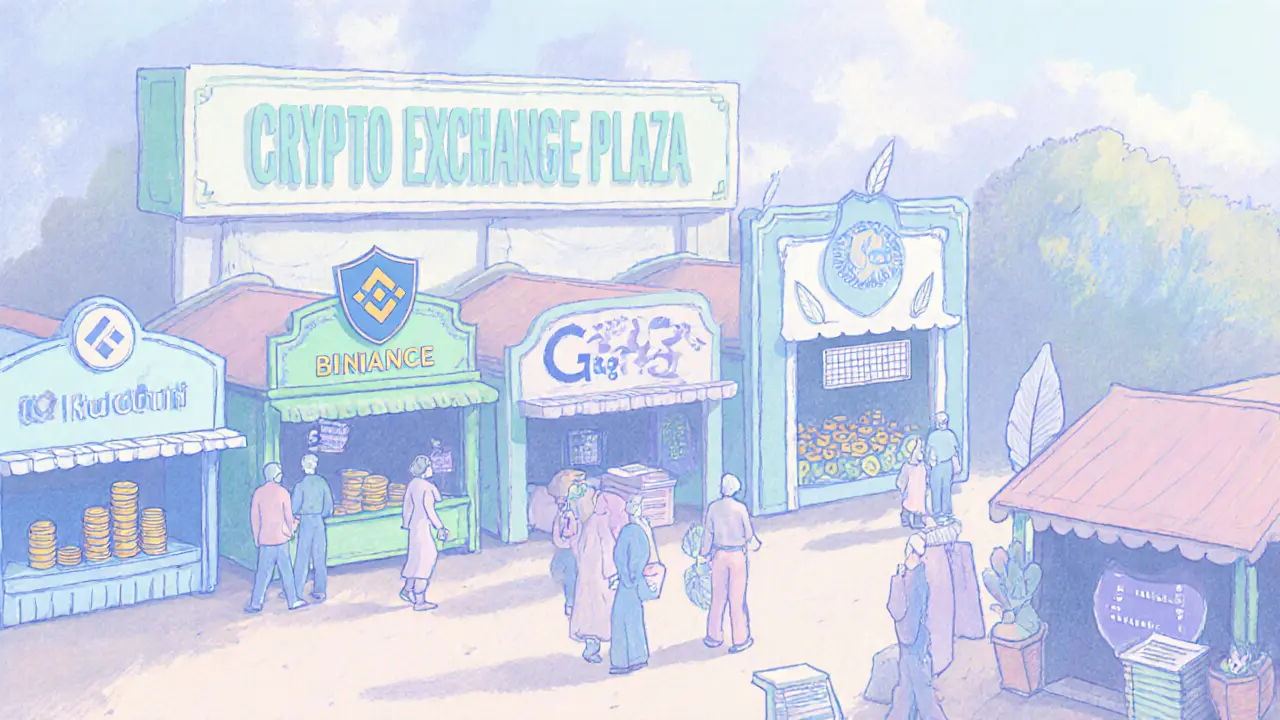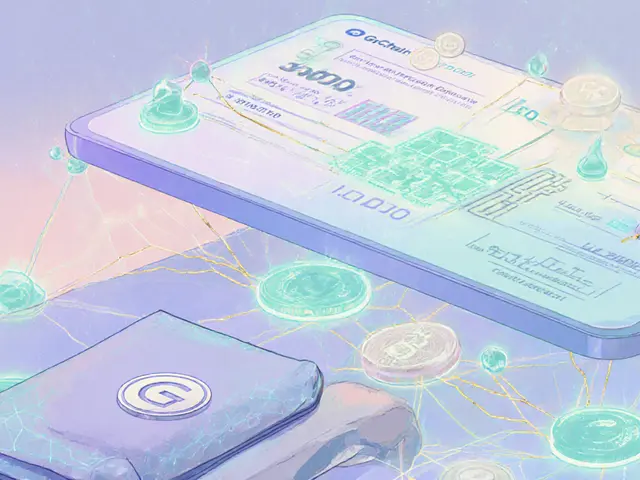Boboo Crypto Exchange Review - What’s Real, What’s Not, and Where to Trade BOBO

BOBO Token Exchange Finder
BOBO is a meme-style cryptocurrency that trades on established exchanges like KuCoin, Binance, CoinEx, Gate, and MEXC. This tool helps you compare exchange features and choose the right one for your needs.
Important Security Note
BOBO token has a centralized ownership model and a blacklist function in its smart contract. This means a single wallet controls ~30% of supply and can freeze user balances. Always verify exchange legitimacy before trading.
When you type Boboo crypto exchange review into a search engine, you expect a rundown of a platform called Boboo - fees, safety, features, the whole package. The reality is a bit different. There is no widely‑known exchange named Boboo. Instead, the name mostly pops up in connection with the BOBO meme token that lives on several established exchanges. This article untangles the confusion, explains what BOBO is, lists the real exchanges where you can buy or sell it, and highlights the security red flags you need to watch.
Is There Actually a Boboo Exchange?
After scanning major exchange directories, community forums, and regulatory registries, we can’t find any platform officially called “Boboo.” The name appears exclusively in token‑related guides - for example, how to purchase BOBO on KuCoin or Binance. That suggests two possibilities:
- The exchange exists under a different brand name and has yet to gain visibility.
- “Boboo” is being mistaken for the BOBO token itself.
Given the absence of a corporate listing, licensing information, or an official website, the safest bet is that a dedicated Boboo exchange does not exist as of October2025. Rather than a review of a non‑existent platform, we’ll focus on the token ecosystem that people associate with the name.
What Is the BOBO Token?
BOBO is a meme‑style cryptocurrency that launched in 2022. It markets itself as a community‑driven “fun” token, but the smart‑contract code tells a more complicated story. Key attributes include:
- Supply: Approximately 1billion tokens, with a sizable portion controlled by a single private wallet.
- Trading pairs: Mostly USDT and BUSD on spot markets.
- Utility: Limited beyond speculation; occasional staking rewards on a few platforms.
The token’s branding (Bobo Cash, BOBO 2.0) has led to several variants, but all share the same underlying contract. Because of its meme nature, price swings can be extreme, and liquidity hinges on a handful of exchanges.
Where Can You Trade BOBO?
If you’re set on buying BOBO, you’ll need to use one of the established exchanges that actually list the token. Below is a quick‑look comparison of the most popular venues as of October2025.
| Exchange | Fee Structure | KYC Requirement | Key Features | Withdrawal Limits |
|---|---|---|---|---|
| KuCoin | 0.1% maker / 0.1% taker | Optional - higher limits after verification | Spot, futures, staking, lending | US$10,000 daily (unverified), up to US$1,000,000 after KYC |
| Binance | 0.1% maker / 0.1% taker | Mandatory for withdrawals > US$2,000 | Spot, margin, Trust Wallet DEX bridge | US$5,000 daily (basic), higher with tiered verification |
| CoinEx | 0.1% maker / 0.1% taker | Optional - privacy‑focused, but limits $10,000 per day | Spot, USDT pairs, fast KYC optional | US$10,000 daily (no KYC), up to US$1,000,000 with KYC |
| Gate | 0% maker / 0.2% taker | Basic email verification; full KYC for high volume | Spot, futures, 130+ fiat pairs | US$5,000 daily (unverified) |
| MEXC | 0% maker / 0% taker for BOBO pairs | Optional - higher limits after KYC | Spot, zero‑maker fees, mobile app | US$10,000 daily (no KYC), up to US$500,000 with KYC |
All five platforms are reputable in the broader market, but each comes with its own trade‑off between convenience, fees, and verification requirements. Choose the one that fits your risk tolerance and how much you plan to move in and out of the token.

Security and Risk Assessment
The biggest red flag for BOBO isn’t the exchange - it’s the token’s contract itself. A security audit by De.Fi highlighted two concerning features:
- Centralized ownership: A single private wallet holds roughly 30% of the total supply, giving that holder outsized influence over price and liquidity.
- Blacklist function: The contract includes a method that can prohibit specific wallets from transferring, swapping, or selling their BOBO. This can be used to freeze assets without user consent.
These mechanisms run counter to the decentralization ethos that many crypto enthusiasts value. If the controlling wallet decides to sell a massive chunk, the price could crash. Likewise, the blacklist could be triggered by a compliance request, effectively locking your funds.
Because of these risks, treat BOBO as a speculative asset rather than a store of value. Only allocate money you can afford to lose, and consider keeping the token on an exchange where you can quickly exit if red flags emerge.
How to Store BOBO Safely
Once you own BOBO, you have two broad storage options:
- Custodial (exchange) wallets: The token stays on the platform you bought it from. This is convenient for active trading, staking, or earning on‑exchange rewards. The downside is that you don’t control the private keys, and a blacklist could affect your balance.
- Non‑custodial wallets: Hardware wallets (Ledger, Trezor), mobile Web3 wallets (Trust Wallet, MetaMask), or even a paper wallet give you full control. You’ll need to handle the private key securely, but you avoid the exchange’s potential restrictions.
For a token with known blacklist capability, many users prefer a non‑custodial solution. However, if you intend to trade frequently, keeping a modest amount on KuCoin or Binance (where you can liquidate fast) may make sense, provided you monitor any policy changes.
Final Verdict - Should You Use a “Boboo Exchange”?
Because a dedicated Boboo exchange appears to be non‑existent, there’s nothing to review in the traditional sense. The real decision is whether to trade the BOBO token on the listed platforms and how to manage its inherent risks. Our recommendation:
- Verify the exchange you choose - check its licensing status in your jurisdiction.
- Limit exposure: Treat BOBO as a high‑risk, high‑volatility meme token.
- Consider non‑custodial storage if you plan to hold for longer than a few weeks.
- Stay updated on any contract upgrades or community proposals that could remove the blacklist feature.
If you were hoping for a dedicated Boboo platform, the closest you’ll get is a suite of established exchanges that support the token. Use them wisely, keep an eye on the audit findings, and remember that “not your keys, not your coins” still applies even for meme tokens.
Frequently Asked Questions
Does the Boboo exchange actually exist?
No verified exchange called Boboo is listed in major crypto directories or regulatory filings. The name mainly refers to the BOBO token, which trades on established platforms.
What is the BOBO token?
BOBO is a meme‑style cryptocurrency launched in 2022. It has about 1billion supply, with a large portion owned by a single private wallet, and includes a blacklist function that can freeze holders’ balances.
Which exchanges allow me to trade BOBO?
As of 2025, KuCoin, Binance, CoinEx, Gate, and MEXC list BOBO. Each has different fee structures, KYC requirements, and withdrawal limits - see the comparison table above.
Is BOBO safe to hold?
The token’s smart contract allows centralized control and blacklisting, which introduces higher risk than most mainstream coins. Only allocate funds you can afford to lose and consider non‑custodial storage.
How can I store BOBO securely?
You can keep BOBO on an exchange for easy trading, or move it to a hardware wallet or a Web3 mobile wallet where you control the private key. Non‑custodial wallets protect you from exchange‑level blacklisting.
What should I watch for after buying BOBO?
Monitor De.Fi audit updates, community proposals that might change the contract, and any exchange policy changes regarding blacklist handling. Rapid price swings are common, so set stop‑loss limits if you trade actively.







If you're scouting for a low‑fee playground for BOBO, KuCoin and Binance still lead the pack. Their maker‑taker fees sit at 0.1% which is reasonable for a meme token that spikes fast. Keep an eye on the KYC tiers – the extra verification can boost your withdrawal caps without too much hassle.
When weighing exchange choices, consider both the fee structure and the community support. A platform with decent liquidity and responsive help can make the volatile BOBO swings more manageable. It's worth checking if the exchange you pick has a clear roadmap for security upgrades.
BOBO's tokenomics present a classic case of centralized risk within a decentralized veneer. The fact that roughly thirty percent of the supply rests in a single wallet means price manipulation potential is high, especially during market dips. Moreover, the blacklist function embedded in the smart contract can freeze balances without any on‑chain consensus, which flips the usual trust model on its head.
From a trading perspective, the five listed exchanges-KuCoin, Binance, CoinEx, Gate, and MEXC-offer comparable fee structures, but they differ in withdrawal limits and KYC strictness. KuCoin’s generous unverified daily limit of $10,000 can be attractive for small‑scale traders, while Binance enforces a $2,000 withdrawal threshold that pushes users toward higher verification tiers.
Liquidity for BOBO is patchy; it spikes on Twitter hype and plummets when sentiment turns sour. Therefore, storing large positions on a custodial exchange is risky not just because of the blacklist, but also due to the exchange’s own policy changes that might restrict token withdrawals.
For those who prefer to retain control, non‑custodial wallets like Ledger or Trust Wallet sidestep exchange‑level blacklisting, yet they demand diligent private‑key management. If you lose your seed phrase, the token is irretrievable, which is a trade‑off you must weigh against the convenience of instant market access.
Given the token’s speculative nature, diversification is advisable. Allocating only a small percentage of your portfolio to BOBO can cushion against sudden market crashes triggered by a large holder dumping tokens.
Stay updated on audit reports from firms like De.Fi, which have highlighted the centralization concerns. Any contract upgrade that removes the blacklist would be a positive sign, but such changes are uncommon without community pressure.
In summary, treat BOBO as a high‑risk, high‑volatility asset: use reputable exchanges for entry and exit, consider non‑custodial storage for longer holds, and keep a tight risk management plan.
From a liquidity‑pool perspective, the concentration of token ownership translates directly into slippage variance on order books. When the dominant wallet engages, the market depth can collapse, leading to execution at far‑worse price points than indicated. Furthermore, the blacklist opcode effectively introduces a conditional transfer restriction, which is atypical for ERC‑20‑like contracts and raises compliance flags for custodial services.
Keep your eye on the fee differentials but don’t let them blind you to the underlying risk. Even a zero‑maker fee on MEXC won’t protect you if the token’s supply can be frozen overnight. Balance the convenience of fast KYC with the prudence of using a hardware wallet for the bulk of your holdings.
Looks like a meme token to me.
From a regulatory standpoint, any platform listing a token with centralized control features must disclose that risk to its users. Failure to do so could be interpreted as a material omission under securities law in several jurisdictions. Consequently, investors should treat BOBO disclosures as a prerequisite before allocating capital.
While the legal angle is critical, the practical side is that you need a solid exit strategy. On Binance, for instance, you can set a stop‑loss order that automatically sells once BOBO hits a predefined threshold, mitigating sudden dumps. Pair that with a non‑custodial backup and you’ve got a multi‑layered safety net.
Philosophically, BOBO’s existence challenges the very notion of decentralization by marrying meme culture with top‑down control. It forces us to ask whether a token’s value is derived from its community narrative or the power vested in a single wallet. The answer often lies somewhere in the gray area between hype‑driven demand and engineered scarcity.
Check the withdrawal caps daily. If you plan to move large sums, verify the tier you need.
Storing BOBO in a hardware wallet gives you the most control, but remember you’ll need to bridge back to an exchange for any liquidity. A hybrid approach-small trading amounts on KuCoin, bulk on Ledger-often works best for meme‑token enthusiasts.
In our region, regulators are tightening on tokens that allow centralized control. If the authorities deem BOBO a security, exchanges may be forced to delist, leaving holders in a precarious spot.
Just a heads up, the market can swing hard on meme tokens. Keep an eye on the news and be ready to act.
I love how BOBO captures the spirit of community‑driven projects, yet it also serves as a cautionary tale about unchecked governance. The token's narrative is built on fun, but the underlying code tells a different story-one where a single entity can tilt the market dramatically. This duality makes it a fascinating study for anyone interested in the intersection of culture and crypto economics.
When you look at the exchange options, KuCoin and Binance provide robust liquidity, which is essential for a token that can move several percentage points in minutes. However, both platforms enforce KYC at certain thresholds, and that can be a stumbling block for users who value privacy. On the other hand, MEXC offers zero‑maker fees for BOBO pairs, a tempting proposition for day‑traders seeking to shave off every basis point.
The blacklist function is a red flag that cannot be ignored. It essentially gives the token's creator a lever to freeze assets, which runs counter to the decentralized ethos that many crypto users champion. If that power is ever exercised, it could trigger a cascade of sell‑offs, further destabilizing the price.
From a risk‑management standpoint, I recommend allocating only a modest portion of your overall portfolio to BOBO. Pair that with a clear exit plan-perhaps a stop‑loss set at 20% below your entry price-to safeguard against sudden dumps. Additionally, consider moving any longer‑term holdings into a non‑custodial wallet where you control the private keys; this reduces exposure to exchange‑level blacklisting.
Finally, stay tuned to audit updates from firms like De.Fi. Any move to remove the blacklist or redistribute the concentrated supply would be a positive signal and could shift the community's perception from speculative gamble to more sustainable investment.
Honestly, I think the hype is overblown. It’s just another meme token with a fancy name.
One could argue that the very existence of a blacklist function embodies the paradox of modern cryptography: the promise of trustless systems undermined by a single point of control. If we accept that premise, then every token with similar design choices becomes a philosophical liability, not merely a financial one.
Stop feeding the meme hype; the token’s architecture is a trap for the unsuspecting.